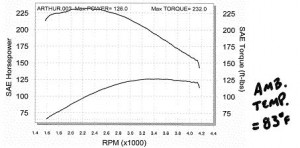by Art Gardner
Your 1949 Cadillac has 160 horsepower, right? Well, maybe, maybe not! The official published number is 160 hp, but what does it mean, how was it measured and how does it stack up to “real world” horsepower? Was Cadillac being overly optimistic to sell cars? Does anyone really think that the cars rolling off the line had 160 hp hitting the ground at the rear wheels?
In the early ‘50’s, hot rodders were drooling over the Cadillac 331 OHV V8 as the most powerful motor available (though expensive for many). A 1951 hot rod magazine reported that the bare ‘49 Cadillac engine (with no generator, water pump, fuel pump, air cleaner, muffler, etc) produced 160 gross BHP at 3800 rpm, the same number Cadillac published but without explaining where it came from. The magazine also reported that with all accessories but the transmission the engine developed 141 net HP at 3400 rpm. Automatic transmissions and the rest of the driveline consume 15-30% of the power available before reaching the rear wheels, while stick shift transmissions consume less, maybe saving 5-10%. Using 20-25% as a rough guess for losses, on a stock Hydramatic ‘49 the 141 flywheel HP was probably only 105-113 HP at the rear wheels, which is the horsepower you can actually use and feel while driving. (Modern automatics are more efficient, due to lock-up torque converters, etc.)
By the way, the 46.5 “taxable horsepower” mentioned in the official published specifications is a theoretical calculation, taking into account the number of cylinders and the bore but not the stroke, and was used primarily in Britain to determine car taxes.
Another measurement is “torque”, which is the twisting power of the engine. It is torque that you actually feel when you step on the gas. One way to think about torque is that it is pure pulling power, while horsepower also takes into account engine speed. A chassis dynamometer is used to measure torque directly and then a horsepower figure is calculated from the torque number (HP=Torque x RPM/5250). Above 5250 rpm, the calculated horsepower will be a larger number than the torque number and the opposite below 5250 rpm (ignoring the units). At 5250 rpm, the horsepower and torque curves cross. The published number for torque on 1949 Cadillac engines is 312 pound feet of torque at 1800 rpm (the calculated HP at this torque measurement would be 107 hp).
I recently tested my engine’s performance. I have the (numbers-matching) early version 1949 Cadillac engine (two-bolt valve covers, spring loaded camshaft) in my 6107 Club Coupe with a few minor changes. First of all, when rebuilding the engine, we did a high-precision balancing and “blueprinting” job to make the engine as smooth and efficient as possible. Second, the engine was bored out 0.030″. Third, I’m using 12 volts, a Pertronix electronic ignition module inside the stock distributor, electronic fuel injection (throttle body) atop the stock intake manifold and a slightly larger exhaust pipe (2-1/4″ vs. 2″). But the engine is still using the small valve 1949 heads with single exhaust. Below is a printout of the horsepower and torque numbers, tested on a local chassis dynamometer (measured at the rear wheels). These numbers are the net numbers after losses by my transmission, rear end, water pump, exhaust, AC compressor, power steering pump, etc.
My peak horsepower number of 126 hp shows a 12%-20% increase over stock, while my peak torque of 232 lb-ft at 2200 rpm is 74% of the published gross torque number of 312 lb-feet at 1800 rpm. Of course, the published torque number would need to be reduced by some percentage to estimate what the torque would have been at the rear wheels and with the engine equipped with normal accessories. If we reduce the published gross torque number to the same extent as the published horsepower number, the net torque at the rear wheels for ’49 Cadillac rolling off the assembly line might have been around 206-220 lb-feet, instead of the gross number of 312 lb-ft. My measured 232 lb-ft of peak torque fits right in with that (a 6%-13% increase).
